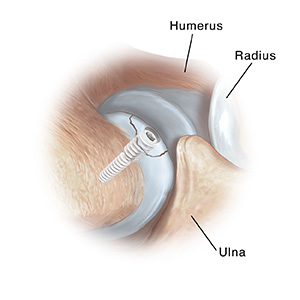Elbow Arthroscopy: Conditions Treated
Elbow Arthroscopy: Conditions Treated
Arthroscopy is used to find and treat many types of elbow problems. These include loose bodies, bone spurs, osteochondritis dissecans (OCD), and synovitis.

Loose bodies are bone or cartilage fragments that have broken loose inside the joint. Left in place, they can cause pain. Your elbow may catch or become hard to bend and straighten. Loose bodies can be removed with arthroscopy. This can help restore normal, pain-free arm movement.

Bone spurs (growths) in a joint can cause the bones to pinch one another (impinge). These growths can cause pain and restrict movement. The ulna is the most common site for bone spurs in the elbow. To treat your problem, the surgeon will remove the spurs and smooth the bone surface.

Inside a joint, a piece of bone can become loose because of an injury to its blood supply. This is most common in children and teens. It can happen from trauma or without any obvious cause. OCD can cause pain and swelling. The surgeon can remove the bone or secure it in place. Open surgery may also be needed. If the bone piece is removed, your surgeon may try to stimulate healing by drilling or by putting holes into the remaining exposed bone.
Synovitis If the lining of the joint (synovium) is pinched, it may become inflamed. This can cause pain and swelling in the elbow. The surgeon can remove the pinched synovium to help relieve symptoms.
Updated:
October 08, 2020
Sources:
Canale, ST, Campbell's Operative Orthopedics (2013); 12; pp.2467-2557
Reviewed By:
Thomas N Joseph MD,Raymond Turley Jr PA-C,L Renee Watson MSN RN